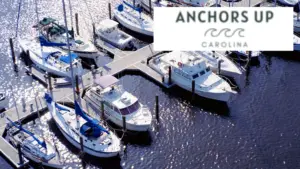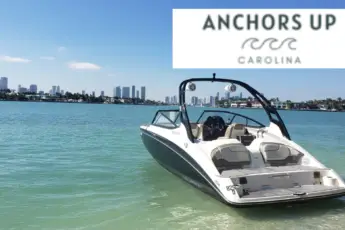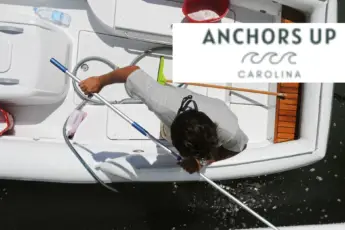Marina dockage is highly sought after by boaters across the United States. Whether you own a boat on a river, lake, or coastal waterway, you’ll find marinas with slip spaces. Significantly, boat owners add convenience when purchasing or paying a monthly fee for in water dockage. Rather than trailering a boat or having it pulled from a dry rack, you can step on and head out. However, this comes with risks. Here is what you need to know about protecting your vessel docked in boat slips.
What Are Boats At Risk When Docked In A Slip
There is no question: boats are at risk when docked at a slip for many reasons. Here is a breakdown of how your vessel can become damaged when docked in a slip.
Boat Wakes
One of the primary reasons that boats become damaged in marina slips is from boat wakes. Boat wakes are caused by boats passing by at speeds higher than idle. Unfortunately, the waves created slam the vessel into the slip.
In most cases, marinas are positioned behind a seawall or in a no wake zone. However, this does not stop some from ignoring the regulations and throwing a massive wake.
Severe Weather
Weather is a factor no matter where you live. Yes, the coastal areas of the southeast are prone to tropical weather, which packs a more powerful punch.
First, passing thunderstorms incorporate strong winds, hail, heavy rain, and lightning. All of the above are factors in causing damage to vessels. I have watched strong winds pull the cushions right off the deck of a boat.
Secondly, hail is another factor in severe weather. Unfortunately, large hail damages windshields in addition to gel coat finishes.
Third, heavy rain is common and can be found in and out of thunderstorms. I was in a situation as a result of heavy rain. The bilge pump on a Cabo fishing boat stopped working in a downpour lasting for hours. The bilge began to fill with water. Fortunately, I had a spare onboard and could replace and suck the accumulated water out before the boat was at risk of sinking.
Lastly, lightning is dangerous for people and vessels at a marina. Unfortunately, I have seen first hand the impact of lightning strikes. Although strikes are not preventable, they cause serious damage to onboard electronics.
Leaks
Without a doubt, vessels sink while secured to the slip. The unsuspecting boat owner fails to realize a leak in through hulls or a failed bilge pump, among other reasons.
Rapid water inundation causes the boat to become unstable and sink. Although the boat is tied to the dock, the damage is more likely than not to be beyond repair. For this reason, I recommend inspecting bilges each and every time you step foot on the boat.
Protect Your Boat In A Slip
Look, you can’t prevent your boat from becoming damaged in all situations when it is secured in the slip. However, you can take measures to reduce the likelihood of costly repairs.
Add A Dock Bumper
A dock bumper adds an extra layer of protection in addition to boat fenders. The bumper affixes to the dock where the vessel makes contact while secured in the slip.
Combining fenders and a bumper helps reduce the likelihood of dock rash. Dock rash is scratching and gouging of the hull from repeated banging in the slip.
Without question, dock rash primarily occurs from boat wakes. The waves cause the boat to strike the dock. For this reason, I recommend adding a dock bumper and fenders.
Hull Leaks And Bilge Pump Issue
Again, hull leaks are challenging to locate unless, of course, water is flowing into the bilge rapidly.
One of the most notable signs of a hull leak is the bilge pump running continuously. In the event the bilge is running consistently, I recommend hauling the boat and having the thru hulls inspected.
A second preventative measure to keep your boat safe at a slip is testing the bilge pump. Yes, bilge pumps become clogged or fail, thus preventing water from accumulating beneath the deck.
I suggest adding two routine maintenance items to your checklist. First, spray the bilge pump filter at the bottom of the pump. Spraying the pump filter prevents the build up of debris, leading to clogs. In addition to cleaning the pump, test the pump monthly to ensure that it is running properly.
Hail Damage
Unfortunately, not much can be said about rescuing the impacts of damage from hail. Hail is uncommon, but when it occurs is capable of producing destruction to windshields, fiberglass, and more. The best approach to preventing hail damage is to cover the vessel after each use.
Lightning
Similar to hail, you won’t have options to prevent damage due to a lightning strike. What is most important is keeping yourself safe. In the event lightning is approaching, get off the boat despite it being secured to the slip. Without a doubt, electronics can be replaced, and people cannot.
Docking At A Slip With Safety In Mind
Measures can be taken to protect your investment when docking at a slip. Avoid costly repairs by adding a dock bumper or testing your bilge pump frequently. I have seen angry boat owners who failed to take the extra step. As a result, the vessel loses its visual appeal because of eye catching damage. Be wise when docking in a marina slip.








